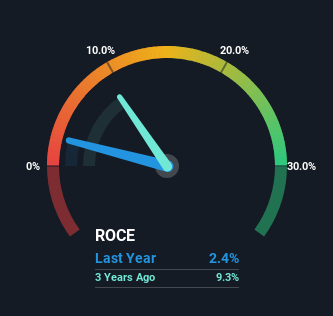- Hong Kong
- /
- Food and Staples Retail
- /
- SEHK:814
These Return Metrics Don't Make Beijing Jingkelong (HKG:814) Look Too Strong
If we're looking to avoid a business that is in decline, what are the trends that can warn us ahead of time? Businesses in decline often have two underlying trends, firstly, a declining return on capital employed (ROCE) and a declining base of capital employed. Ultimately this means that the company is earning less per dollar invested and on top of that, it's shrinking its base of capital employed. So after glancing at the trends within Beijing Jingkelong (HKG:814), we weren't too hopeful.
Return On Capital Employed (ROCE): What Is It?
For those who don't know, ROCE is a measure of a company's yearly pre-tax profit (its return), relative to the capital employed in the business. To calculate this metric for Beijing Jingkelong, this is the formula:
Return on Capital Employed = Earnings Before Interest and Tax (EBIT) ÷ (Total Assets - Current Liabilities)
0.024 = CN¥61m ÷ (CN¥7.5b - CN¥5.0b) (Based on the trailing twelve months to June 2023).
Thus, Beijing Jingkelong has an ROCE of 2.4%. Ultimately, that's a low return and it under-performs the Consumer Retailing industry average of 9.4%.
Check out our latest analysis for Beijing Jingkelong

While the past is not representative of the future, it can be helpful to know how a company has performed historically, which is why we have this chart above. If you'd like to look at how Beijing Jingkelong has performed in the past in other metrics, you can view this free graph of past earnings, revenue and cash flow.
What Can We Tell From Beijing Jingkelong's ROCE Trend?
In terms of Beijing Jingkelong's historical ROCE movements, the trend doesn't inspire confidence. To be more specific, the ROCE was 15% five years ago, but since then it has dropped noticeably. And on the capital employed front, the business is utilizing roughly the same amount of capital as it was back then. Companies that exhibit these attributes tend to not be shrinking, but they can be mature and facing pressure on their margins from competition. So because these trends aren't typically conducive to creating a multi-bagger, we wouldn't hold our breath on Beijing Jingkelong becoming one if things continue as they have.
On a separate but related note, it's important to know that Beijing Jingkelong has a current liabilities to total assets ratio of 66%, which we'd consider pretty high. This can bring about some risks because the company is basically operating with a rather large reliance on its suppliers or other sorts of short-term creditors. While it's not necessarily a bad thing, it can be beneficial if this ratio is lower.
The Bottom Line On Beijing Jingkelong's ROCE
In summary, it's unfortunate that Beijing Jingkelong is generating lower returns from the same amount of capital. Investors haven't taken kindly to these developments, since the stock has declined 62% from where it was five years ago. With underlying trends that aren't great in these areas, we'd consider looking elsewhere.
If you want to know some of the risks facing Beijing Jingkelong we've found 3 warning signs (2 are concerning!) that you should be aware of before investing here.
If you want to search for solid companies with great earnings, check out this free list of companies with good balance sheets and impressive returns on equity.
Valuation is complex, but we're here to simplify it.
Discover if Beijing Jingkelong might be undervalued or overvalued with our detailed analysis, featuring fair value estimates, potential risks, dividends, insider trades, and its financial condition.
Access Free AnalysisHave feedback on this article? Concerned about the content? Get in touch with us directly. Alternatively, email editorial-team (at) simplywallst.com.
This article by Simply Wall St is general in nature. We provide commentary based on historical data and analyst forecasts only using an unbiased methodology and our articles are not intended to be financial advice. It does not constitute a recommendation to buy or sell any stock, and does not take account of your objectives, or your financial situation. We aim to bring you long-term focused analysis driven by fundamental data. Note that our analysis may not factor in the latest price-sensitive company announcements or qualitative material. Simply Wall St has no position in any stocks mentioned.
About SEHK:814
Beijing Jingkelong
Engages in the retail and wholesale distribution of daily consumer products.
Good value with mediocre balance sheet.
Market Insights
Community Narratives




